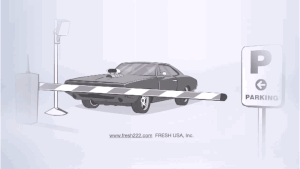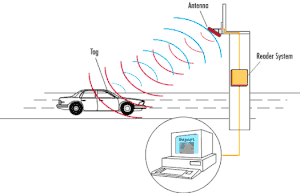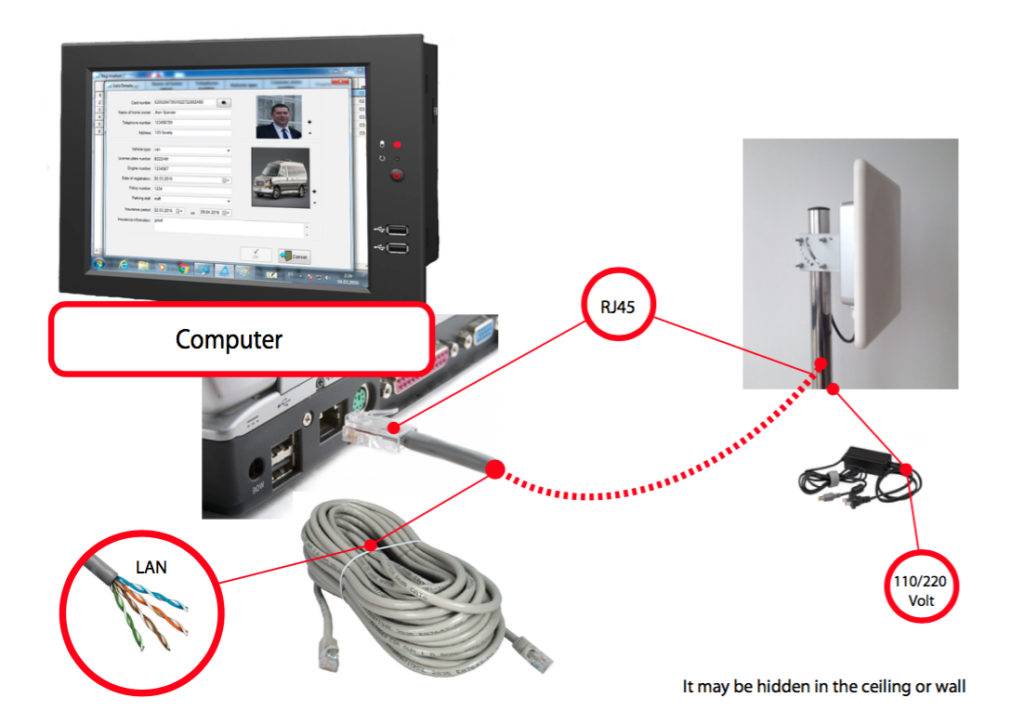An RFID vehicle access control system is a specific type of RFID UHF (Ultra High Frequency) system that operates at higher frequencies, typically in the range of 860 to 960 MHz. This technology is specifically designed for vehicle access control and offers distinct advantages over other RFID systems.
RFID Vehicle Access Control: A Comprehensive Guide
At our Fresh USA company, we understand the significance of efficient and secure vehicle access control systems. In this comprehensive guide, we delve into the world of RFID (Radio Frequency Identification) technology and its role in revolutionizing vehicle access control. With our expertise in the field, we aim to provide you with valuable insights and knowledge that will help you make informed decisions for your organization’s access control needs.
PRICE / Buy Access Control System, range 26ft / 8m
PRICE / Buy Access Control System, range 49ft / 15m
Introduction to RFID Vehicle Access Control
RFID technology has emerged as a game-changer in the realm of vehicle access control. With its ability to wirelessly transmit data, RFID offers seamless and reliable identification solutions, enhancing security, convenience, and operational efficiency. Unlike traditional access control methods such as physical keys or swipe cards, RFID provides a contactless means of granting access, making it more user-friendly and reducing the risk of unauthorized entry.


How RFID Vehicle Access Control Works
At the core of RFID vehicle access control is the RFID tag, which consists of an integrated circuit and an antenna. The tag is affixed to a vehicle, typically on the windshield or license plate, and contains unique identification data. When the vehicle approaches an RFID reader installed at a controlled access point, the reader emits a radio signal that activates the tag. The tag responds by transmitting its stored information back to the reader, enabling quick and accurate identification.
Advantages of RFID Vehicle Access Control
-

vehicle access control solutions RFID Enhanced Security: RFID technology provides a higher level of security compared to traditional access control methods. The unique identification codes of RFID tags make it extremely difficult to clone or counterfeit, reducing the risk of unauthorized access.
- Convenience and Efficiency: With RFID vehicle access control, drivers no longer need to manually present cards or use physical keys to gain entry. The contactless nature of RFID streamlines the process, improving traffic flow and reducing waiting times at access points.
- Data Capture and Analytics: RFID systems can collect valuable data on vehicle movements, entry times, and more. This data can be leveraged for various purposes, including traffic analysis, optimizing access control procedures, and generating insights for operational improvements.
- Integration Capabilities: RFID technology seamlessly integrates with other systems, such as parking management or security systems, allowing for centralized control and increased operational efficiency.
Types of RFID Vehicle Access Control Systems
-
-

RFID Vehicle Access Control Sticker Passive RFID Systems: In passive RFID systems, the RFID tag does not have an internal power source. Instead, it relies on the energy emitted by the reader to activate and transmit data. Passive RFID systems are cost-effective and suitable for various access control scenarios.
- Active RFID Systems: Active RFID systems utilize tags with built-in power sources, such as batteries. These tags can transmit signals over longer distances and offer increased read ranges. Active RFID systems are often used in applications where real-time monitoring and tracking of vehicles are required.
- Hybrid RFID Systems: Hybrid systems combine the benefits of both passive and active RFID technologies. They are versatile and can be customized to meet specific access control requirements. Hybrid systems are particularly useful in environments where vehicles may operate both in close proximity and at a distance from readers.
-
PRICE / Buy Access Control System, range 26ft / 8m
PRICE / Buy Access Control System, range 49ft / 15m
Implementing RFID Vehicle Access Control
To implement an effective RFID vehicle access control system, several key considerations should be taken into account:
-
-
- Site Assessment: Conduct a thorough assessment of the site to determine the number and optimal locations for RFID readers. Consider factors such as entry points, traffic flow, and any potential obstacles that could affect signal transmission.
- Tag Selection: Choose RFID tags that are suitable for your specific application. Factors such as read range, durability, and attachment methods should be considered when selecting tags.
- Reader Placement: Strategically position RFID readers to ensure maximum coverage and reliable tag detection. Consider the height, angle, and orientation of the readers for optimal performance.
- Integration and Scalability: Ensure that the RFID vehicle access control system can integrate with existing systems and is scalable to accommodate future expansions or modifications.
-
Conclusion
RFID vehicle access control systems offer a reliable, secure, and convenient solution for managing vehicle entry and enhancing overall security. With its ability to streamline access procedures, provide valuable data insights, and integrate with other systems, RFID technology has become a cornerstone of modern access control strategies. By implementing an RFID vehicle access control system tailored to your organization’s needs, you can optimize operational efficiency, improve security, and stay ahead in today’s dynamic world.
Use of Long-Range Wireless Technologies In Vehicle Access Control Systems

RFID vehicle access control systems manufactured by FRESH USA have been tested for many years of use around the world and work perfectly in all weather conditions. Our systems use only contactless technologies such as Wi-Fi, 4G / LTE, and RFID UHF long range distance with a frequency of 860MHz – 960MHz. You can integrate the parking management software with other third-party software or your ERP system using a SQL database or deploy a Web-service.
Any RFID system, from Fresh USA is Your reliable choice.
The main advantage of a Vehicle Access Control System with RFID UHF technology is the high read range, which allows for efficient and convenient access control of vehicles without the need for physical contact or line-of-sight communication.
At our Fresh USA company, we specialize in delivering comprehensive and innovative RFID vehicle access control solutions. Contact us today to learn how we can help you implement a cutting-edge access control system that meets your unique requirements and surpasses your expectations.

Chicago RFID Vehicle Access Control Systems
RFID Vehicle Access Control Systems
Imagine driving up to a secure facility and gaining instant access without rolling down your window or fumbling for a card. This seamless experience is made possible by RFID (Radio Frequency Identification) vehicle access control systems. These systems are transforming how we manage vehicle entry and exit, providing a blend of convenience, security, and efficiency that traditional methods struggle to match.
What is an RFID Vehicle Access Control System?
Definition and Basic Functionality
An RFID vehicle access control system uses radio waves to identify and authenticate vehicles as they approach an access point. The system comprises RFID tags attached to vehicles and RFID readers installed at entry and exit points. When a vehicle with an RFID tag comes within range of a reader, the system verifies the tag’s information and grants or denies access based on predefined criteria.
Historical Background and Evolution
RFID technology dates back to World War II, initially used for identifying friendly aircraft. Over the decades, it has evolved and found applications in various fields, including inventory management, livestock tracking, and now vehicle access control. The advancements in RFID technology have made it more reliable, cost-effective, and widely adopted in security and access management.
Components of RFID Vehicle Access Control Systems
RFID Tags
Types of RFID Tags
- Passive Tags: Do not have an internal power source and rely on the reader’s signal for power. They are cost-effective and suitable for most vehicle access control applications.
- Active Tags: Have a built-in battery, providing a longer read range and more reliability in challenging environments.
Installation and Placement
RFID tags are typically placed on the windshield or license plate of a vehicle. The placement ensures clear communication with RFID readers and minimizes signal interference.
RFID Readers
Types of RFID Readers
- Fixed Readers: Permanently installed at access points like gates or barriers.
- Handheld Readers: Portable devices used for temporary access control or in areas where fixed readers are impractical.
Installation and Coverage Area
RFID readers must be strategically installed to cover the desired detection area. Factors like range, angle, and potential obstructions are considered to ensure optimal performance.
Control Panels and Software
Centralized Management
Control panels and software act as the system’s brain, processing data from RFID readers and making access decisions. They provide centralized management, allowing administrators to monitor and control access from a single interface.
User Interfaces and Reporting
User-friendly interfaces enable administrators to configure the system, manage user permissions, and generate reports on access events and system performance.
How RFID Vehicle Access Control Systems Work
Communication Between Tags and Readers
When a vehicle with an RFID tag approaches a reader, the reader emits a signal that powers the tag (in the case of passive tags). The tag then sends its unique identification information back to the reader.
Data Processing and Access Decision
The reader transmits the tag’s information to the control panel, where it is checked against a database of authorized vehicles. Based on the data, the system either grants or denies access.
Integration with Other Security Systems
RFID vehicle access control systems can be integrated with other security measures like CCTV cameras, alarm systems, and biometric verification to provide a comprehensive security solution.
Advantages of RFID Vehicle Access Control Systems
Enhanced Security
RFID systems provide a high level of security by ensuring only authorized vehicles gain access. The unique identification codes on RFID tags are difficult to duplicate, preventing unauthorized entry.
Increased Efficiency and Convenience
RFID systems allow for quick and seamless access, reducing wait times and improving traffic flow at entry and exit points. Drivers do not need to stop, show ID, or interact with security personnel.
Cost-Effectiveness
Compared to traditional access control methods, RFID systems are cost-effective. The initial setup and maintenance costs are relatively low, and the systems require minimal human intervention.
Scalability
RFID systems are highly scalable, making them suitable for various applications, from small residential complexes to large industrial facilities. Additional tags and readers can be easily added as needed.
Applications of RFID Vehicle Access Control Systems
Residential and Gated Communities
RFID systems enhance security and convenience in residential areas, ensuring that only residents and authorized visitors can enter.
Commercial and Office Buildings
In commercial settings, RFID systems manage employee and visitor vehicle access, improving security and operational efficiency.
Industrial Facilities
Industrial sites benefit from RFID systems by controlling access to sensitive areas and managing the flow of vehicles within the facility.
Parking Lots and Garages
RFID systems streamline parking operations, allowing for automated entry and exit, and efficient space management.
Toll Booths and Highways
RFID technology is widely used in toll collection, enabling quick and automated toll payments and reducing traffic congestion.
Implementing RFID Vehicle Access Control Systems
Planning and Site Assessment
A thorough site assessment is crucial for determining the optimal placement of RFID readers and ensuring adequate coverage.
Selection of Appropriate Technology
Choosing the right type of RFID tags and readers based on the specific requirements of the site is essential for effective implementation.
Installation Process
The installation process involves mounting RFID readers, placing tags on vehicles, and setting up the control panel and software.
Testing and Optimization
After installation, the system is tested to ensure it functions correctly. Adjustments are made as needed to optimize performance.
Maintenance and Upgrades
Regular maintenance ensures the system operates smoothly. Upgrades may be necessary to keep up with technological advancements and changing security needs.
Challenges and Considerations
Environmental Factors
Weather conditions and physical obstructions can affect RFID performance. Using appropriate equipment and placement strategies can mitigate these issues.
Interference and Signal Blockage
Electronic interference from other devices can disrupt RFID signals. Ensuring proper installation and using high-quality equipment can reduce interference.
Data Privacy and Security
Protecting the data collected by RFID systems is crucial. Implementing strong encryption and access control measures can safeguard sensitive information.
Cost and Budget Constraints
While RFID systems are cost-effective, the initial setup cost can be significant. Planning and budgeting are essential for successful implementation.
Future Trends in RFID Vehicle Access Control Systems
Advancements in RFID Technology
Ongoing advancements in RFID technology will lead to better performance, increased range, and enhanced security features.
Integration with AI and IoT
The integration of AI and IoT will enable more intelligent and adaptive RFID systems, capable of learning from patterns and making predictive decisions.
Increased Use of Mobile and Cloud-Based Solutions
Mobile apps and cloud-based platforms will offer greater flexibility and convenience, allowing users to manage access remotely.
Enhanced Cybersecurity Measures
As RFID systems become more connected, robust cybersecurity measures will be essential to protect against hacking and data breaches.
Making a Choice of Vehicle Access Control Systems Call to Fresh USA
RFID vehicle access control systems are revolutionizing how we manage vehicle entry and exit, providing unparalleled security, efficiency, and convenience. From residential areas to industrial facilities, these systems offer versatile solutions tailored to various needs. As technology advances, RFID systems will continue to evolve, integrating AI, IoT, and enhanced cybersecurity to meet future challenges. Call us today to get fine quote.
FAQs
- What is the main advantage of using RFID for vehicle access control?
- The main advantage is the seamless and efficient access it provides, reducing wait times and enhancing security.
- How secure are RFID vehicle access control systems?
- RFID systems are highly secure due to unique identification codes and the difficulty of duplicating RFID tags.
- Can RFID systems be used in extreme weather conditions?
- Yes, with proper installation and the use of weather-resistant equipment, RFID systems can function effectively in extreme conditions.
- What is the cost of implementing an RFID vehicle access control system?
- Costs vary based on the scale and complexity of the system but typically include expenses for tags, readers, control panels, and installation.
- How can RFID systems be integrated with existing security infrastructure?
- RFID systems can be easily integrated with other security measures like CCTV, alarm systems, and biometric verification for a comprehensive security solution.




